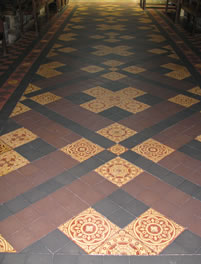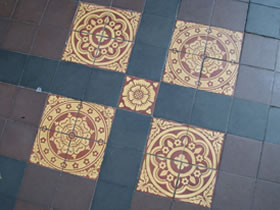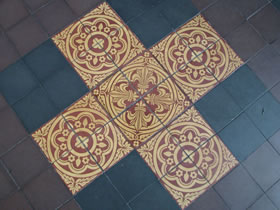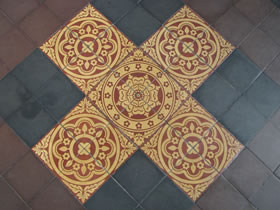Skip over navigation
In a public building in England, I found this wonderful tiled floor:

Really interesting I thought, because so much that looked the same at first glance was in fact different.
Look at the three images of the patterns I found along the centre of the tiling (below).



What is the same about them and what is different?
Now look again at the picture of the whole of the main tiled area. It was made from nine complete patterns each like one of the three above.
At the ends there were partial patterns, both like the one in the foreground. The pattern was surrounded by a rectangle of black tiles with some further tiling beyond.
Describe the pattern.
How many of each type of tile are included in the pattern?
How could you check?
Can you reproduce parts of the pattern?
Can you extend it sideways?



Or search by topic
Number and algebra
Geometry and measure
Probability and statistics
Working mathematically
Advanced mathematics
For younger learners
Tiles in a Public Building
Age 7 to 11
Challenge Level 





- Problem
- Teachers' Resources
In a public building in England, I found this wonderful tiled floor:

Really interesting I thought, because so much that looked the same at first glance was in fact different.
Look at the three images of the patterns I found along the centre of the tiling (below).



What is the same about them and what is different?
Now look again at the picture of the whole of the main tiled area. It was made from nine complete patterns each like one of the three above.
At the ends there were partial patterns, both like the one in the foreground. The pattern was surrounded by a rectangle of black tiles with some further tiling beyond.
Describe the pattern.
How many of each type of tile are included in the pattern?
How could you check?
Can you reproduce parts of the pattern?
Can you extend it sideways?
You may also like
Clock Hands
This investigation explores using different shapes as the hands of the clock. What things occur as the the hands move.
Transformation Tease
What are the coordinates of this shape after it has been transformed in the ways described? Compare these with the original coordinates. What do you notice about the numbers?
Penta Play
A shape and space game for 2, 3 or 4 players. Be the last person to be able to place a pentomino piece on the playing board.

